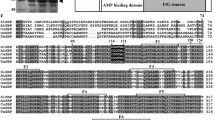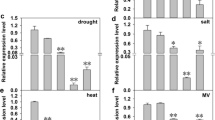Abstract
Key message
The overexpression of tomato GDP- l -galactose phosphorylase gene enhanced tolerance to chilling stress and reduced photoinhibition of photosystems I and II in transgenic tobacco.
Abstract
Chilling stress is a crucial factor that limits the geographical distribution and yield of chilling-sensitive plants. Ascorbate (AsA) protects plants by scavenging reactive oxygen species and reduces photoinhibition by promoting the conversion of violaxanthin to zeaxanthin in the xanthophyll cycle to dissipate excess excitation energy. Possible mechanisms of AsA for plant photoprotection under chilling stress were investigated by isolating the tomato GDP-l-galactose phosphorylase gene (SlGGP) and producing transgenic tobacco plants with overexpression of SlGGP. The transgenic plants subjected to chilling stress accumulated less H2O2, demonstrated lower levels of ion leakage and malondialdehyde, and acquired higher net photosynthetic rate, higher maximum photochemical efficiency of PSII, and higher D1 protein content compared with the wild-type (WT) plants. The transgenic plants subjected to chilling stress also showed higher GDP-l-galactose phosphorylase activity, increased AsA content as well as ascorbate peroxidase and oxidizable P700 activities than WT plants. Thus, SlGGP overexpression is crucial in promoting AsA synthesis and alleviating photoinhibition of two photosystems.







Similar content being viewed by others
Abbreviations
- APX:
-
Ascorbate peroxidase
- AsA:
-
Ascorbate
- DAB:
-
Diaminobenzidin
- DHA:
-
Dehydroascorbate
- ELISA:
-
Enzyme-linked immunosorbent assay
- Fv/Fm:
-
The maximal photochemical efficiency of PSII
- GGP:
-
GDP-l-galactose phosphorylase
- IPTG:
-
Isopropyl β-d-1-thiogalactopyranoside
- NBT:
-
Nitroblue tetrazolium
- PFD:
-
Photon flux density
- Pn:
-
The net photosynthetic rate
- PVDF:
-
Polyvinylidene fluoride
- ROS:
-
Reactive oxygen species
- TBA:
-
Thiobarbituric acid
- WT:
-
Wild type
References
Andersson B, Aro EM (2001) Photodamage and D1 protein turnover in photosystem II. In: Andersson B, Aro EM (eds) Regulation of Photosynthesis. Kluwer Academic, Dordrecht, pp 377–393
Asada K (1999) The water-water cycle in chloroplasts: scavenging of active oxygen and dissipation of excess photons. Annu Rev Plant Physiol Plant Mol Biol 50:601–639
Barth C, Moeder W, Klessig DF, Conklin PL (2004) The timing of senescence and response to pathogens is altered in the ascorbate-deficient Arabidopsis mutant vitamin c-1. Plant Physiol 134:1784–1792
Bradford MM (1976) A rapid and sensitive method for the quantitation of microgram quantities of protein utilizing the principle of proteinedye-binding. Anal Biochem 72:248–254
Bulley SM, Rassam M, Hoser D, Otto W, Schunemann Ni, Wright M, MacRae E, Gleave A, Laing W (2009) Gene expression studies in kiwifruit and gene over-expression in Arabidopsis indicates that GDP-l-galactose guanyltransferase is a major control point of vitamin C biosynthesis. J Exp Bot 60:765–778
Bulley S, Wright M, Rommens C, Yan H, Rassam M, Wang KL, Andre C, Brewster D, Karunairetnam S, Allan AC, Laing WA (2012) Enhancing ascorbate in fruits and tubers through over-expression of the l-galactose pathway gene GDP-l-galactose phosphorylase. Plant Biotech J 10:390–397
Chen Z, Gallie DR (2006) Dehydroascorbate reductase affects leaf growth, development and function. Plant Physiol 142:775–787
Conklin PL (2001) Recent advances in the role and biosynthesis of ascorbic acid in plants. Plant Cell Environ 24:383–394
de Pinto MC, Tommasi F, De Gara L (2006) Hydrogen peroxide, nitric oxide and cytosolic ascorbate peroxidase at the crossroad between defence and cell death. Plant J 48:784–795
Dowdle J, Ishikawa T, Gatzek S, Rolinski S, Smirnoff N (2007) Two genes in Arabidopsis thaliana encoding GDP-l-galactose phosphorylase are required for ascorbate biosynthesis and seedling viability. Plant J 52:673–689
Foyer CH, Noctor G (2005) Redox homeostasis and antioxidant signalling: a metabolic interface between stress perception and physiological responses. Plant Cell 17:1866–1875
Gao Q, Zhang LX (2008) Ultraviolet-B-induced oxidative stress and antioxidant defense system responses in ascorbatedeficient vtc1 mutants of Arabidopsis thaliana. J Plant Physiol 165:138–148
Giacomelli L, Rudella A, van Wijk KJ (2006) High light response of the thylakoid proteome in Arabidopsis wild type and the ascorbate-deficient mutant vtc2-2. A comparative proteomics study. Plant Physiol 141:685–701
Gilbert L, Alhagdow M, Nunes-Nesi A, Quemener B, Guillon F, Bouchet B, Faurobert M, Gouble B, Page D, Garcia V, Petit J, Stevens R, Causse M, Fernie AR, Lahaye M, Rothan C, Baldet P (2009) The GDP-d-mannose 3,5-epimerase (GME) plays a key role at the intersection of ascorbate and non cellulosic cell wall biosynthesis in tomato. Plant J 60:499–508
Hodges DM, De Long JM, Forney CF, Prange RK (1999) Improving the thiobarbituric acid-reactive-substances assay for estimating lipid peroxidation in plant tissues containing anthocyanin and other interfering compounds. Planta 270:604–611
Ishikawa T, Shigeoka S (2008) Recent advances in ascorbate biosynthesis and the physiological significance of ascorbate peroxidase in photosynthesizing organisms. Biosci Biotechnol Biochem 72:1143–1154
Kotchoni SO, Larrimore KE, Mukherjee M, Kempinski CF, Barth C (2009) Alterations in the endogenous ascorbic acid content affect flowering time in Arabidopsis. Plant Physiol 149:803–815
Kwon SY, Jeong YJ, Lee HS, Kim JS, Cho KY, Allen RD, Kwark SS (2002) Enhanced tolerance of transgenic tobacco plants expressing both superoxide dismutase and ascorbate peroxidase in chloroplasts against methyl viologen-mediated oxidative stress. Plant Cell Environ 25:873–882
Laing WA, Wright MA, Cooney J, Bulley SM (2007) The missing step of the l-galactose pathway of ascorbate biosynthesis in plants, an l-galactose guanyltransferase, increases leaf ascorbate content. Proc Natl Acad Sci USA 104:9534–9539
Li F, Wu QY, Sun YL, Wang LY, Yang XH, Meng QW (2010) Overexpression of chloroplastic monodehydroascorbate reductase enhanced tolerance to temperature and methylviologen-mediated oxidative stresses. Physiol Plant 139:421–434
Linster CL, Clarke SG (2008) l-Ascorbate biosynthesis in higher plants: the role of VTC2. Trends Plant Sci 13:567–573
Linster CL, Gomez TA, Christensen KC, Adler LN, Young BD, Brenner C, Clarke SG (2007) Arabidopsis VTC2 encodes a GDP-l-galactose phosphorylase, the last unknown enzyme in the Smirnoff-Wheeler pathway to ascorbic acid in plants. J Biol Chem 282:18879–18885
Mano J, Ushimaru T, Asada K (1997) Ascorbate in thylakoid lumen as an endogenous electron donor to photosystem II: protection of thylakoids from photoinhibition and regeneration of ascorbate in stroma by dehydroascorbate reductase. Photosynth Res 53:197–204
Mittler R, Vanderauwera S, Gollery M, van Breusegem F (2004) The reactive oxygen gene network of plants. Trends Plant Sci 9:490–498
Müller-Moulé P, Talila G, Niyogi KK (2004) Ascorbate-deficient mutants of Arabidopsis grow in high light despite chronic photooxidative stress. Plant Physiol 134:1163–1172
Padh H (1990) Cellular functions of ascorbic acid. Biochem Cell Biol 68:1166–1173
Pignocchi C, Foyer CH (2003) Apoplastic ascorbate metabolism and its role in the regulation of cell signalling. Curr Opin Plant Biol 6:379–389
Pokorska B, Zienkiewicz M, Powikrowska M, Drozak A, Romanowska E (2009) Differential turnover of the photosystem II reaction centre D1 protein in mesophyll and bundle sheath chloroplasts of maize. Biochim Biophys Acta 1787:1161–1169
Rao MV, Davis KR (1999) Ozone-induced cell death occurs via two distinct mechanisms in Arabidopsis: the role of salicylic acid. Plant J 17:603–614
Sairam PK, Srivastava GC (2002) Changes in antioxidant activity in sub-cellular fractions of tolerant and susceptible wheat genotypes in response to long term salt stress. Plant Sci 162:897–904
Sasaki-Sekimoto Y, Taki N, Obayashi T, Aono M, Matsumoto F, Sakurai N, Suzuki H, Hirai MY, Noji M, Saito K, Masuda T, Takamiya K, Shibata D, Ohta H (2005) Coordinated activation of metabolic pathways for antioxidants and defence compounds by jasmonates and their roles in stress tolerance in Arabidopsis. Plant J 44:653–668
Schansker G, Srivastava A, Govindjee, Strasser RJ (2003) Characterization of the 820-nm transmission signal paralleling the chlorophyll a fluorescence rise (OJIP) in pea leaves. Funct Plant Biol 30:785–796
Terashima I, Noguchi K, Itoh-Nemoto T, Park YM, Kubo A, Tanaka K (1998) The cause of PSI photoinhibition at low temperatures in leaves of Cucumis sativus, a chilling sensitive plant. Physiol Plant 103:295–303
Van Kooten O, Snel JPH (1990) The use of chlorophyll fluorescence nomenclature in plant stress physiology. Photosynth Res 25:147–150
Wang AG, Luo GH (1990) Quantitative relation between the reaction of hydroxylamine and superoxide anion radicals in plants. Plant Physiol 6:55–57
Wang HS, Yu C, Zhu ZJ, Yu XC (2011) Overexpression in tobacco of a tomato GMPase gene improves tolerance to both low and high temperature stress by enhancing antioxidation capacity. Plant Cell Rep 30:1029–1040
Wang LY, Li D, Deng YS, Lv W, Meng QW (2013) Antisense-mediated depletion of tomato GDP-l-galactose phosphorylase increases susceptibility to chilling stress. J Plant Physiol 170:303–314
Wheeler GL, Jones MA, Smirnoff N (1998) The biosynthetic pathway of vitamin C in higher plants. Nature 393:365–369
Wolucka BA, Goossens A, Inze D (2005) Methyl jasmonate stimulates the de novo biosynthesis of vitamin C in plant cell suspensions. J Exp Bot 56:2527–2538
Yang XH, Wen XG, Gong HM, Lu QT, Yang ZP, Tang YL, Liang Z, Lu CM (2007) Genetic engineering of the biosynthesis of glycinebetaine enhances thermotolerance of photosystem II in tobacco plants. Planta 225:719–733
Zhang S, Scheller HV (2004) Photoinhibition of photosystem I at chilling temperature and subsequent recovery in Arabidopsis thaliana. Plant Cell Physiol 45:1595–1602
Zhang LX, Paakkarinen V, van Wijk KJ, Aro EM (1999) Cotranslational assembly of the D1 protein into photosystem II. J Biol Chem 274:16062–16067
Zhang CJ, Liu JX, Zhang YY, Cai XF, Gong PJ, Zhang JH, Wang TT, Li HX, Ye ZB (2010) Overexpression of SlGMES leads to ascorbate accumulation with enhanced oxidative stress, cold, and salt tolerance in tomato. Plant Cell Rep 30:389–398
Acknowledgments
This research was supported by the Natural Science Foundation of China (31171474, 31371553), Science and technology project of higher education of Shandong Province (J13LE12), Natural Science Foundation of Shandong Province, China (ZR2013CL006).
Conflict of interest
The authors declare that they have no conflict of interest.
Author information
Authors and Affiliations
Corresponding author
Additional information
Communicated by K. Toriyama.
Rights and permissions
About this article
Cite this article
Wang, L., Meng, X., Yang, D. et al. Overexpression of tomato GDP-l-galactose phosphorylase gene in tobacco improves tolerance to chilling stress. Plant Cell Rep 33, 1441–1451 (2014). https://doi.org/10.1007/s00299-014-1627-2
Received:
Revised:
Accepted:
Published:
Issue Date:
DOI: https://doi.org/10.1007/s00299-014-1627-2




